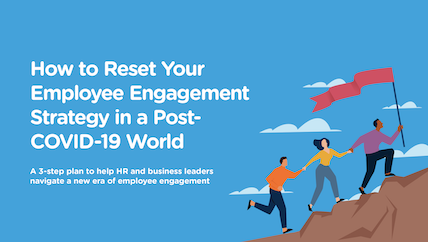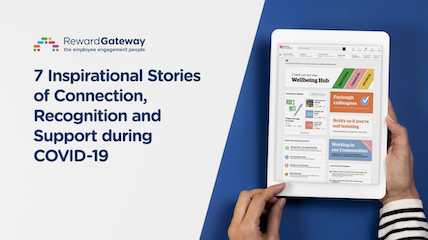Get more detail on Debra's 3-step plan to reset employee engagement strategies and programmes in a post-COVID-19 world.
Learn more »
Although the COVID-19 pandemic has certainly been a daunting time, it has also provided a once-in-a-lifetime opportunity for HR leaders. Like many companies who are resetting their business strategies, you now have a unique opportunity to reset your own post-pandemic employee engagement strategy and approach.
No matter what your business has faced during the COVID-19 pandemic, what's important is how you come out on the other side.
If we seize the moment, we can rise out of this unique time having learned invaluable (and unforeseen) lessons, and come out with stronger and more lasting engagement than at the start.
Josh Bersin, Global Industry Analyst, calls this moment in time 'The Big Reset.' He describes it as a new way of thinking about work, life, business and leadership, and will be based on a reset of our expectations, priorities and how we spend our time.

Are you ready to reset your employee engagement strategy? We can help.
Schedule a DemoWorking with Debra Corey, Owner of HR consulting firm DebCo HR LTD, we’ve developed a three-step plan that others can use to evolve their own employee engagement strategy:

Though these three steps are sequential, they can vary business-to-business, especially as your people's needs and expectations change. The most important point is not to let perfectionism get in the way of progress – be nimble, be agile and get your new programmes and technology out there, quickly.
The first step in the process is to assess, which is where you pause to reassess and evaluate the following:
The second step in the process is when you decide the 'how.' This is when you'll determine how you’re going to change any programmes from the previous step that you want to continue. Based on your new objectives, you may also use this step to build new programmes that deliver on those objectives.
There are three parts to this step: Gaining feedback, rebuilding or building new programmes and then doing a gap analysis to make sure you haven’t missed anything.
The final step in the process is to connect, which is where you connect all of your findings to move actions forward, reconnecting and engaging with your workforce to execute your strategy.
There are three parts to this step, starting with planning the actual changes, planning how you will re-educate your managers to support the changes, and planning how to re-engage your workforce with your programmes.
No matter what engagement solutions you may be looking at, whether that’s a new wellbeing initiative, a renewed focus on digital reward and recognition programmes or a natural evolution of your employee communications, this 3-step process can help you determine what to keep and what to leave behind to usher in a new era for your business.
By choosing the right mix of solutions to connect, recognise and support your workforce, you'll be well-equipped for the next 'new normal' we're approaching.

Get more detail on Debra's 3-step plan to reset employee engagement strategies and programmes in a post-COVID-19 world.
Learn more »
See how others have started to reset their employee engagement strategy with the right mix of solutions to connect, recognise and support their people.
Learn more »
Hear from industry experts on how leaders can connect with and engage employees to manage change, while strengthening trust, morale and productivity.
Watch now »
Fiona Buchanan, EVP
Causeway
Products
Request a demo
+44 20 7229 0349Reward Gateway Integrations
Open API | Yapster | Amazon | MS Teams | Slack | All Integrations
Topics
Employee Benefits Scheme | Corporate Perks | Employee Perks | Staff Perks | Social Recognition | Benefits Management | Employee Experience Platform | Corporate Discounts
Copyright © 2024. Cookie Policy | Privacy Notice | Site Map